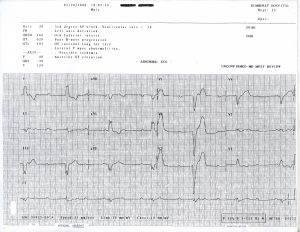A 75 year-old male with a history of systolic heart failure, hypertension, diabetes, hyperlipidemia, and COPD presents with complaints of shortness of breath to the ED. he presents with this ECG.
A quick look at this ECG demonstrates bradycardia with 3rd degree heart block, left bundle branch block (LBBB) morphology, and possibly ST elevation. The first thing to notice in this ECG is that there is no communication between the p-waves and the QRS complexes. The p waves march out in a regular pattern however the p waves and QRS complexes are completely independent of each other qualifying this as 3rd degree heart block. Looking more closely, you can see that the QRS complexes demonstrate left bundle branch block morphology. The QRS beats are wide complex (greater than 120 ms), there is a large dominant S wave in lead V1, there are broad and or notched R waves in I, V5, V6, and aVL and left axis deviation is present. Importantly you also see that QRS beats and T waves are NOT concordant. This is normal in LBBB morphology and is called appropriate discordance. In the anterior leads you may notice ST elevation of approximately 5 mm. However in LBBB morphology up to 5 mm of elevation is acceptable as long as the T wave and QRS complexes are (appropriately) discordant. In leads with concordance of the QRS complex and T waves, ST elevation greater than 1 mm is significant and may suggest ischemia. This patient is also quite bradycardic at a rate of 38. It is tempting in the presence of ST elevation to suspect MI as the cause of the slow heart rate however bradycardia usually occurs in the setting of an inferior wall MI, not anterior wall. There is no ST elevation in the inferior leads of this ECG to suggest inferior wall MI and, as stated previously, the ST elevation in the anterior leads is probably acceptable in the setting of appropriate discordance. A repeat ECG for dynamic changes would be advisable to look for progression to greater elevation or “tomb stoning”. Beware, in this ECG the positive QRS complex followed by the positive T wave in the middle of the ECG at the beginning of V2 are from different leads and do not indicate concordance.
Learning points:
Complete or 3rd degree heart block occurs when p waves and QRS complex are not only delayed but completely independent of each other.
In LBBB morphology you usually see wide complex beats, left axis deviation, large dominant S wave in lead V1, and broad and or notched R waves in I, V5, V6, and aVL.
LBBB often demonstrate appropriate discordance in which QRS complexes and T waves are opposite each other. ST elevation up to 5 mm is normal in this scenario.
Usually bradycardia from MI is caused by inferior wall MI and other etiology should be suspected if no ischemic changes are seen in leads II, II and aVF.

